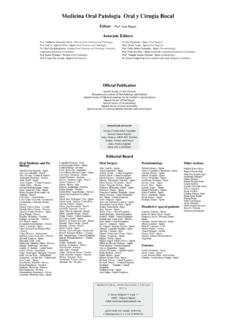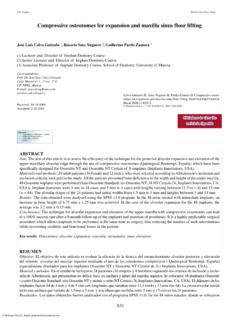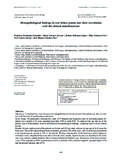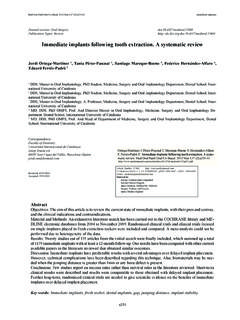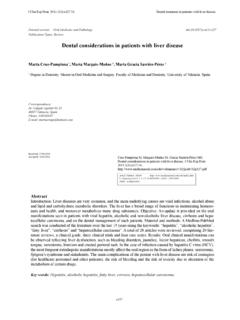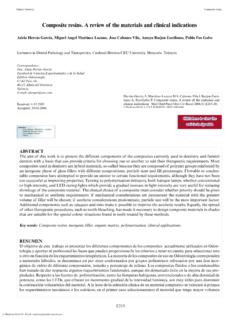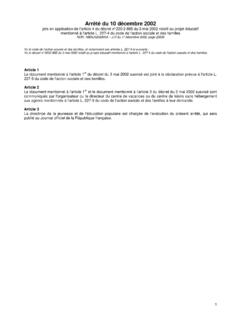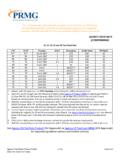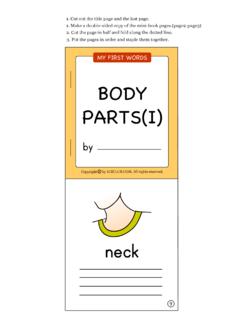Transcription of Cri du chat syndrome: A critical review - Med Oral …
1 Med Oral Patol Oral Cir Bucal. 2010 May 1;15 (3):e473-8. Cri du chat syndromee473 Journal section: Special patients Types: ReviewCri du chat syndrome : A critical review ngela Rodr guez-Caballero 1, Daniel Torres-Lagares 2, Antonio Rodr guez-P rez 1, Mar a- ngeles Serrera-Figallo 3, Jos -Mar a Hern ndez-Guisado 3, Guillermo Machuca-Portillo 41 Doctoral Fellow. Master in Integrated Dentistry of Adults and Special Patients.
2 Departament of Dentistry. University of Se-villa2 Regular Doctor Proffesor. Oral Surgery. Departament of Dentistry. University of Sevilla3 Associated Proffesor. Integrated Dentistry of Adults and Special Patients. Departament of Dentistry. University of Sevilla4 Titular Proffesor. Director of Master in Integrated Dentistry of Adults and Special Patients. Departament of Dentistry. Univer-sity of SevillaCorrespondence:Facultad de Odontolog a de Sevilla Hospital Virgen del Roc oC/ Avicena s/n41009 Sevilla, 22/03/2009 Accepted: 20/09/2009 AbstractA new syndrome was identified in 1963, when Lejeune et al. reported a genetic disease resulting from a partial or total deletion on the short arm of chromosome 5 (5p-) and named it the cri du chat syndrome (CdCS).
3 This term makes reference to the main clinical feature of the syndrome , a high-pitched monochromatic cat-like crying, that usually disappears in the first years of is one of the most common chromosomal deletion syndromes in humans, with an incidence of 1 purpose was to review different aspects of this syndrome (concept, epidemiology, aetiology, clinical features, diagnostic methods and prognosis) emphasizing both: the breakthrough in this field introduced by new cytoge-netic and molecular techniques, and the orofacial manifestations most frequently main orofacial anomalies registered were mandibular microretrognathia, high palate but rarely cleft, variable malocclusion (frequently anterior open-bite), enamel hypoplasia, poor oral hygiene, generalized chronic perio-dontitis, and retardation of tooth eruption, although there is not enough evidence to support any clear association between these pathologies and the words: cri du chat syndrome , chromosome disorders, orofacial manifestation.
4 Rodr guez-Caballero A, Torres-Lagares D, Rodr guez-P rez A, Serrera-Figallo MA, Hern ndez-Guisado JM, Machuca-Portillo G. cri du chat syndrome : A critical review . Med Oral Patol Oral Cir Bucal. 2010 May 1;15 (3):e473-8. Number: 2761 Medicina Oral S. L. B 96689336 - pISSN 1698-4447 - eISSN: 1698-6946eMail: Indexed in: -SCI EXPANDED-JOURNAL CITATION REPORTS-Index Medicus / MEDLINE / PubMed -EMBASE, Excerpta Medica-SCOPUS-Indice M dico Espa ol Med Oral Patol Oral Cir Bucal. 2010 May 1;15 (3):e473-8. Cri du chat syndromee474 DefinitionThe Cry du Chat syndrome (CdCS) was first described by Lejeune et al.
5 (1) in 1963. The name of the syndrome refers to the most characteristic clinical feature, a high-pitched crying similar to the mewing of a cat, which usually disappears in the first years of syndrome results from a total or partial deletion on the short arm of the chromosome 5 (5p-) (range from 35% to 55%) being associated with a de novo deletion in more than 80 percent of the cases (2).In recent years, the application of genetic molecular methods introduced advances in the diagnosis and typification of the CdCS. Our purpose is to update the knowledge in this direction, and to review the main clinical features and oral manifestations in this syn-drome that requires special odontological being considered a rare genetic autosomal di-sorder, CdCS is one of the most common chromosomal syndromes in humans (3).
6 The first epidemiological stu-dies estimated the prevalence at 1 in live-births, nevertheless subsequent studies suggested a greater pre-valence at 1 in live-born infants (3). The inciden-ce in females is slightly higher (1,3), however significant differences in the distribution of CdCS among races or geographical areas has not been the mentally retarded population CdCS repre-sents less than 1 percent. Concerning this subject of study, Niebuhr (3) reported a proportion of 1:350 bet-ween individuals with a mental handicap. Likewise, any outstanding association with prenatal events, age of parents, or location according to order of birth within the family has not been established (3). A survey of 27 mothers made by Cornish y Pigram (1996) showed that 37% had suffered some kind of anomaly during the pregnancy.
7 The labor had been complicated in 44% of the cases (4). Occasionally, parental exposi-tion to radiation and maternal disease, including hype-remesis, anorexia, toxemia and vaginal bleeding were reported (3). Etiopathogenesis Like it was described by Lejeune et al. in 1963, the CdCS is a dysmorphogenic syndrome consisting in a chromosomopathy caused by a partial or total deletion of genetic material on the short arm of the chromosome 5. The size of the deletion could affect from region 5p to the complete loss of the short of the cases are due to a de novo deletion (around 80%), a little more than 10% of the cases are originated by a parental translocation, and less than 10% are asso-ciated with cytogenetic rare aberrations (3).
8 By evalua-ting a sample of 80 patients and 148 parents Mainardi et al. (2) discovered that of the patients showed a terminal deletion; an interstitial deletion; 5% a de novo translocation; a familiar translocation; a mosaic with two cellular lines and the 1% re-maining showed a pericentric inversion. This deletion often has a paternal origin (80-90% of the cases) (2). Niebuhr was the first one to identify the specific chromo-somal region involved in CdCS (5p ) through cytogenetic analysis. Thanks to the breakthrough intro-duced by cytogenetic molecular analysis based on in situ hybridization (FISH) we have been able to develop more precise studies in which areas within this region related to certain clinical features of the syndrome have been identified (2).
9 The breakpoints have a range from p13 to (2), and within this interval we can dis-tinguish two regions; one associated with the typical crying of the CdCS (located in 5p ), and the other associated with dysmorphism, microcephaly and men-tal handicap (located in 5p ) (2). Clinical Neonatal periodDuring the neonatal period the typical cry is probably the most characteristic and striking clinical feature in newborns and young children. It is a weak, monoto-nous, high-pitched crying similar to the mewing of a cat (1) that usually disappears within a few months or years of life, however the duration of its existence is contro-versial. As an exception, isolated atypical cases have been reg-istered where the crying was not present or instead there was a persistent stridor during the inspiration.
10 Neverthe-less, we could not consider it a pathognomonical sign of the syndrome , because it has also been found in certain kinds of disorders or neurologic diseases (3). The pathogenesis of this crying was attributed to mor-phologic laryngeal alterations by the first published cas-es (1): flappy, small and curved epiglottis, hypoplastic, narrow and diamond-shaped or quadrangular larynx, having an abnormal air space in the posterior area dur-ing phonation (5,6). Nevertheless, subsequent studies established that these anatomical alterations were not necessarily present in every patient, therefore the ex-istence of some other organic and/or functional factors were not being considered (5). Currently the pathogen-esis is associated not only with anatomical alterations in the epiglottis and the larynx but also with structural and/or functional neurological alterations (5, 6).
